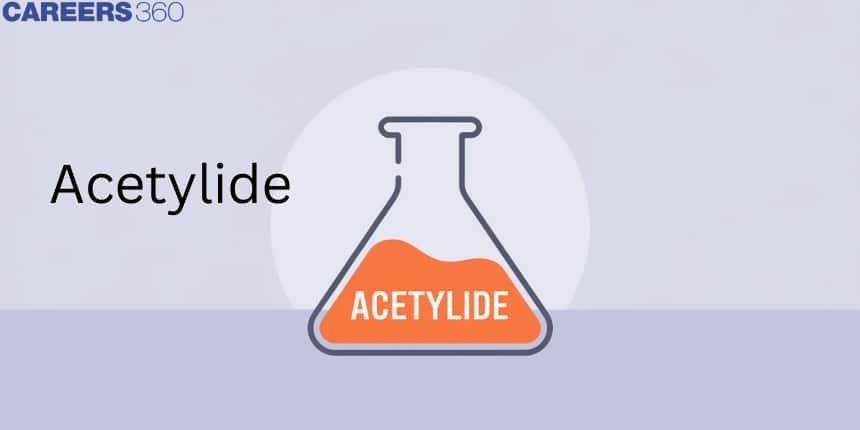Acetylide: Structure, Bonding, Reactions, Preparation of Acetylides
Acetylides refer to a class of compounds in which a metal is attached to an alkyne. The general formula for acetylides is RC≡CM, where R is an organic side chain.
This Story also Contains
- Structure And Bonding Of Acetylides
- Reactions Of Acetylides
- Favorskii Reaction
- Coupling Reactions
- Preparation Of Acetylides
- Applications
- Dangers

Acetylide is a well-known reagent used in the synthesis of organic compounds. They are also formed as intermediates in coupling reactions.
Structure And Bonding Of Acetylides
When Acetyl Metals Combine with Alkali Metals or acetylides, alkaline earth metals exhibit ionic character. Hydrolysis of these compounds can confirm evidence of the ionic character of the acetylides.
Hydrolysis of acetylides is done and acetylene and metal oxides are formed.
When acetylides bind to transition metals, they exhibit covalent character.
Acetylide shows similar properties to its double-substituted analogue.
In the absence of ligands, metal acetylides exhibit polymeric structures with acetylide groups as bridging ligands.
Reactions Of Acetylides
Acetylides are used in alkynylation reactions in organic chemistry.
Acetylide functions as a nucleophile in various electrophilic and unsaturated substrate reactions.
Favorskii Reaction
The Favorskii reaction is a chemical reaction between an alkyne and a carbonyl compound under strongly basic conditions to produce an alkynol. It was discovered by Russian chemist Alexei Favorsky in the early 1900s.
Coupling Reactions
A reaction in which two chemical species combine is called a coupling reaction.
A reaction between an organic halide and an organometallic compound is an example of a coupling reaction.
Preparation Of Acetylides
With the help of Alkyne
The synthesis of acetylides from alkynes uses organometallic or inorganic superbases.
Liquid ammonia is used in the synthesis of acetylides from alkenes.
Ether-based solvents are also used to synthesize acetylides from alkenes.
Organolithium reagents such as lithium amide, LiHMDS, and ethyl lithium are commonly used in the synthesis of lithium acetylides.
Inorganic reagents such as sodium amides are commonly used to synthesize sodium or potassium acetylides at room temperature and atmospheric pressure.
Copper (I) acetylide is synthesized by passing copper chloride through acetylene.
Silver nitrate is commonly used in the synthesis of silver acetylides.
Calcium carbide is produced by heating lime, or calcium oxide, with coal to about 2,000 °C.
Lithium carbide is produced by heating lithium oxide, or lithium oxide, together with carbon to about 2,000 °C. Strong bases such as KOH react with acetylene to form potassium acetylide.
Further reactions with alcohols or aldehydes give Favorskii products.
N-Butyllithium deprotonates ethyl propionates to synthesize the corresponding acetylide.
It is also formed as an intermediate in the coupling reaction.
Applications
Acetylides are highly sensitive to water and are used as explosives.
To test acetylene, gaseous copper acetylide is passed through a copper (I) chloride solution.
Copper acetylide is used in petrochemicals.
Copper acetylide is used in industry to form tubes.
Acetylide is also used to test for the presence of terminal alkynes in organic synthesis.
Dangers
Some acetylides are notoriously explosive.
Acetylide formation is a risk when handling gaseous acetylene in the presence of higher-grade metals or alloys.
Toxin acts on the skin system as it can cause skin irritation and allergic skin reactions.
It also affects the eye system, as contact with the eyes can cause serious eye damage and eye irritation.
It also adversely affects the respiratory tract when inhaled.
Frequently Asked Questions (FAQs)
Acetylides refer to a class of compounds in which a metal is attached to an alkyne. The general formula for acetylides is RC≡CM, where R is an organic side chain. Acetylide is a well-known reagent used in the synthesis of organic compounds. They are also formed as intermediates in coupling reactions.
When Acetyl Metals Combine with Alkali Metals or acetylides, alkaline earth metals exhibit ionic character. Hydrolysis of these compounds can confirm evidence of the ionic character of the acetylides.
Hydrolysis of acetylides is done and acetylene and metal oxides are formed.
When acetylides bind to transition metals, they exhibit covalent character.
Acetylide shows similar properties to its double-substituted analogue.
In the absence of ligands, metal acetylides exhibit polymeric structures with acetylide groups as bridging ligands.
The uses of Acetylides are -
Acetylides are highly sensitive to water and are used as explosives.
To test acetylene, gaseous copper acetylide is passed through a copper (I) chloride solution.
Copper acetylide is used in petrochemicals.
Copper acetylide is used in industry to form tubes.
Acetylide is also used to test for the presence of terminal alkynes in organic synthesis.
It is prepared in the following way-
With the help of Alkyne
The synthesis of acetylides from alkynes uses organometallic or inorganic superbases.
Liquid ammonia is used in the synthesis of acetylides from alkenes.
Ether-based solvents are also used to synthesize acetylides from alkenes.
Organolithium reagents such as lithium amide, LiHMDS, and ethyl lithium are commonly used in the synthesis of lithium acetylides.
Inorganic reagents such as sodium amides are commonly used to synthesize sodium or potassium acetylides at room temperature and atmospheric pressure.
Copper (I) acetylide is synthesized by passing copper chloride through acetylene.
Silver nitrate is commonly used in the synthesis of silver acetylides.
Calcium carbide is produced by heating lime, or calcium oxide, with coal to about 2,000 °C.
Lithium carbide is produced by heating lithium oxide, or lithium oxide, together with carbon to about 2,000 °C. Strong bases such as KOH react with acetylene to form potassium acetylide
Dangers caused by acetylides are-
Some acetylides are notoriously explosive.
Acetylide formation is a risk when handling gaseous acetylene in the presence of higher-grade metals or alloys.
Toxin acts on the skin system as it can cause skin irritation and allergic skin reactions.
It also affects the eye system, as contact with the eyes can cause serious eye damage and eye irritation.
It also adversely affects the respiratory tract when inhaled.